 I recently watched a new Google Partner video about automation strategies. The video features Frederick Vallaeys, one of the original AdWords team engineers, and discusses ways to use automated bidding strategies, rules, and scripts to increase efficiency and effectiveness in AdWords to improve an account’s return on investment.
I recently watched a new Google Partner video about automation strategies. The video features Frederick Vallaeys, one of the original AdWords team engineers, and discusses ways to use automated bidding strategies, rules, and scripts to increase efficiency and effectiveness in AdWords to improve an account’s return on investment.
In this post, I’ll focus on breaking down the what, why, and how of automated bidding strategies.
Automated Bid Strategy Basics
Bid Management — what to bid for which keywords under what conditions — is no small task, and many vendors offer bid management solutions to help. Google, however, offers within AdWords its own Automated Bid Strategies that use raw computer power to implement business decisions.
The chart below features a list of these strategies. If, for example, you selected “maximize clicks” for a particular campaign, Google would look for the cheapest keywords and try to deliver the most clicks possible for your budget.
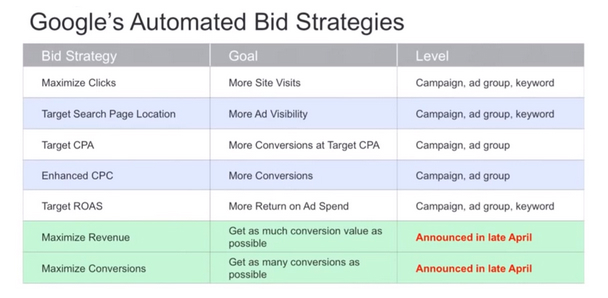
As you can see, there are AdWords bid strategies beyond just maximizing clicks. Users can now opt for Target CPA strategies, where the bid isn’t for a single click but rather the Cost Per Acquisition (of a conversion, like a sale or signup).
These CPA bid strategies use conversion value information to help businesses optimize for conversions. As Vallaeys points out, Google AdWords is the only platform that can do this. You tell Google AdWords what you’re willing to pay for a conversion, your target CPA, and it attempts to make bid decisions based on historical information to get you there.
Using Automated Bid Strategies to Improve AdWords Performance
Multiple AdWords bid strategies can be used in tandem and at various levels to better optimize an account, hence why Google refers to them in AdWords as “flexible” bid strategies. In Vallaey’s video, he created a scenario of a business filtering out keywords into three groups: High Converters, Known Converters, and Unknown.
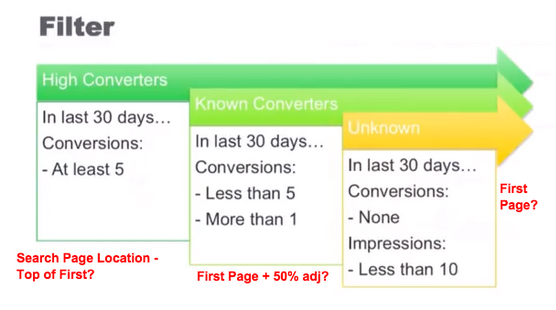
Once those keyword lists are organized into conceptual “buckets” based on conversion performance, different bid strategies can then be applied to them. Let’s walk through Vallaeys’ example:
High Converters
High Converters are keywords that are delivering the goods. Clicks on these keywords are more likely to lead to conversions, so applying a “Target Search Page Location – Top of Page” strategy might make a lot of sense.
Known Converters
For Known Converters, or keywords that have a history of converting, a strategy to hit the first page plus a “bid adjustment” to improve AdRank, may be appropriate. The ads aren’t targeted for the top of page (where they presumably cost more), but they are competing for real estate higher on the search engine results page (SERP) to make them more competitive.
Quick note: Vallaey points out in the video that his data supports the argument that Google underestimates the cost of a first page bid, so please just keep that in mind when setting your bids and adjustments.
Unknown Converters
Finally, Unknown Converters are keywords with something to prove. These keywords could benefit from a first page strategy to increase exposure and help build data about their contribution. If one keyword becomes a clear standout, you can always promote it by switching its flexible bid strategy to target the top of the first page, in the pantheon of other keywords that are can-do when it comes to conversions.
How to Implement Flexible Bidding Strategies
Fortunately, implementing flexible bid strategies in AdWords is pretty straightforward. The “Bid Strategy” dropdown is an option at the Campaign, Ad Group, and even the Keyword level. Here’s how it looks:
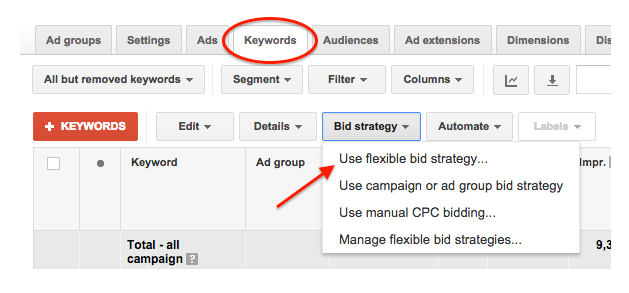
If you haven’t yet set up bid strategies yet, don’t worry. These are readily available for activation in your AdWords Shared Library, easily accessible in the left column of your account screen:
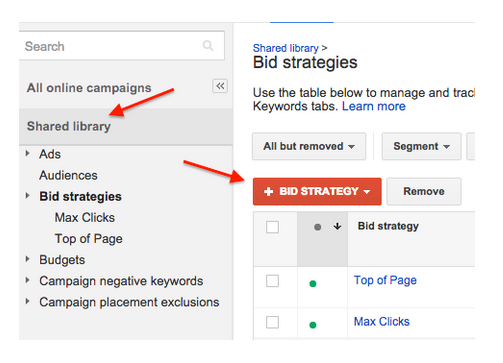
After you have created your flexible bid strategy of choice, you can configure it. For example, the Known Converter keywords in the above scenario were hypothetically targeted to become more competitive on the first page of results. Here’s what it looks like to create the corresponding “Target Search Page Location” bid strategy, direct it to target the top of the first page of search results, and include a bid adjustment to increase competitiveness:
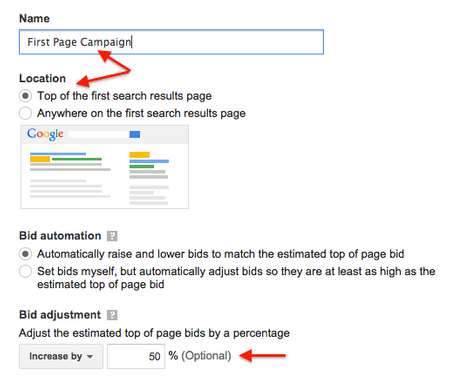
Automated Bidding Strategies are Only the Beginning!
Automatic bidding strategies are a powerful tool that leverages what computers do best, number crunching. The strategies themselves, however, still ultimately rely on humans to choose appropriate strategies to achieve desired objectives.
Automated Bid Strategies can’t build your business for you, but it can do wonders to keep you working smarter, not harder. And it’s only the beginning! Automated rules and scripts are up next.
Want to make AdWords sing? Contact us today for a free consultation.
Graphics via Google Partners video on AdWords automation.

